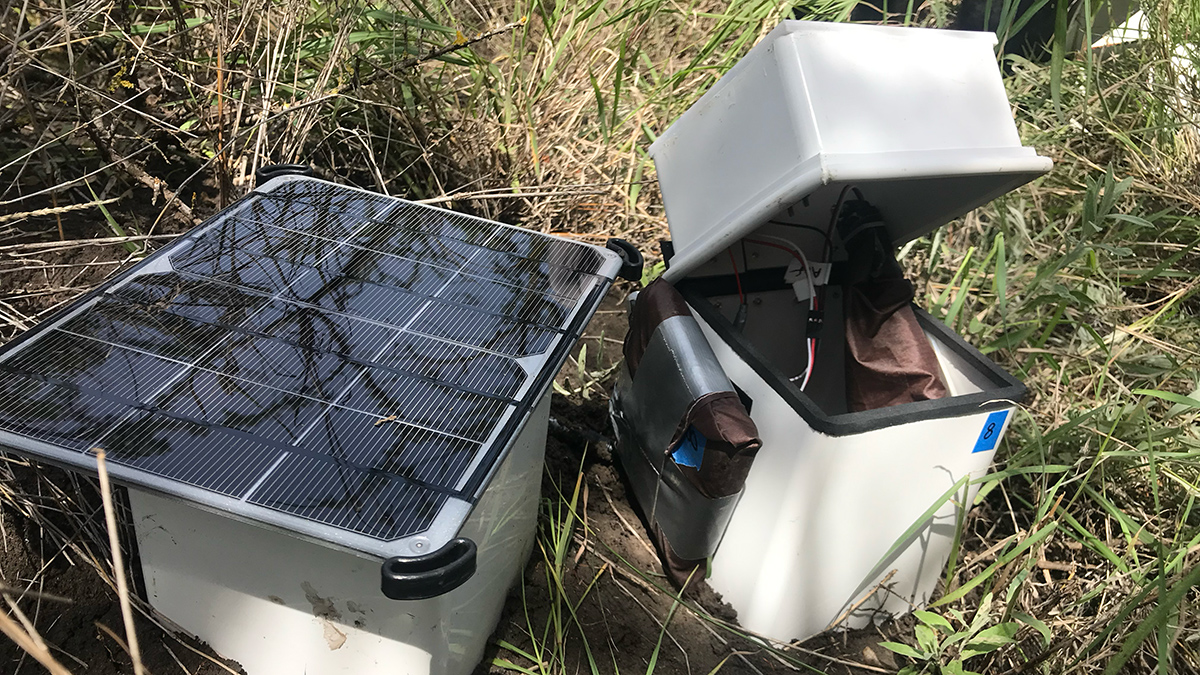When Elizabeth Forbes walked into an enormous spiderweb and its weaver at the Mpala Research Centre in the Kenyan savanna, she was most worried about the approximately $45,000 carbon dioxide flux chamber in her backpack.
“The first thing I did was carefully take the backpack off, put it on the ground, and then freak out and try to get the spider off me,” she said.
Forbes was conducting research on how the loss of large herbivores affects carbon cycles in the savanna for her doctorate in ecology at the University of California, Santa Barbara. Lugging around an expensive, heavy instrument wasn’t ideal for long field days (or spider encounters), so she set out to create a more affordable way to measure soil carbon flux.
Soil carbon flux, or the rate at which carbon dioxide (CO2) is exchanged between the atmosphere and the soil, provides key information about an ecosystem’s carbon budget. Massive amounts of carbon are stored in Earth’s soils, but anything from respiring microbes to cracks in soil to anthropogenic activities such as deforestation can cause that carbon to move into the atmosphere.
“Soil carbon serves as the primary energy source for microorganisms and exerts a fundamental influence on soil structure and ecosystem productivity.”
“Measuring soil carbon flux…is central to understanding terrestrial ecosystem dynamics,” wrote George Koech, an ecologist at Mpala, in an email. “Soil carbon serves as the primary energy source for microorganisms and exerts a fundamental influence on soil structure and ecosystem productivity.”
However, gathering detailed data on soil carbon flux is traditionally either time-consuming or expensive. And standard methods aren’t continuous. Expensive autonomous instruments can’t be left unattended overnight where they could be trampled by animals or flooded by rain. “You kind of need to babysit them,” said Kathleen Savage, a biogeochemist at the Woodwell Climate Research Center. This leaves many areas without data on nighttime and postrainfall fluxes.
“A lot of the field is looking at lower-cost options, where you kind of sacrifice a little bit of the resolution, or how sensitive your instrument is, but you gain something more affordable,” said Savage, who researches greenhouse gas fluxes from natural systems. She has developed some of these low-cost options herself but was not involved in the new instrument design.
To manually gather soil carbon flux data, researchers insert a cylindrical collar a few centimeters into the ground. They then place a CO2 sensor on top, trapping and measuring the CO2 being emitted by the soil.
Forbes and her colleagues instead engineered a set of 18 lidded devices they call fluxbots. Each is a bit larger than a loaf of bread and costs about $367 to build.
“Instead of having to walk around with the little sensor version and plop it on top of these collars, the collar was the robot,” said Forbes, now a postdoctoral research fellow at Yale School of the Environment. “The robot was just inserted into the soil, and the lid would open and close, sort of on a predetermined schedule.”
The researchers installed the fluxbots in the Kenya Long-Term Exclosure Experiment at Mpala on plots with and without large herbivores. At both sites, they were distributed both beneath trees and in open areas.

The fluxbots collected hourly data for almost 2 months in 2019, resulting in more than 10,000 soil carbon flux measurements. The researchers published their findings in Journal of Geophysical Research: Biogeosciences earlier this year and will present more results at AGU’s Annual Meeting 2023 in San Francisco.
Moisture’s Surprising Role
Carbon flux tends to correlate with heat: The warmer the soil temperature is, the more active microbes are, and the higher the carbon flux is. Surprisingly, the team found that carbon flux at Mpala was higher at night. They suggested that in ecosystems with high heat and limited water, soil carbon flux is more tightly coupled to moisture than to temperature. They also found that flux levels were lower beneath tree canopies than in open areas and higher in areas with herbivores than without. They theorized that the reason is that large animals such as elephants can disturb soil and cause higher flux.
Forbes noted the fluxbots made it possible to gather data that would otherwise have been inaccessible. Nevertheless, the team recommended several improvements for future fluxbot iterations, one of which is already in the works. One change is an adapter collar that would allow researchers to validate a fluxbot’s measurements on the same soil footprint as the fluxbot itself.
“It’s a big leap, and it’s relatively cost-effective.”
With the original instrument, researchers cross-checked the data by measuring a nearby soil patch. But because carbon flux can vary significantly over small areas, validating the results was complicated. Savage agreed with the suggested fluxbot upgrade, noting her group does the same with devices they have developed.
The low-cost fluxbots could be particularly useful in the Global South, Savage said, because many of those countries don’t have sufficient data to do their carbon accounting. Some, such as the Democratic Republic of the Congo, even rely on measurements of other countries’ carbon levels to estimate their own.
Instruments such as the fluxbots are “perfect” for these countries to make their own measurements in their own forest, Savage said. “It’s a big leap, and it’s relatively cost-effective.”
—Emily Dieckman (@emfurd), Associate Editor


